Technology

Wow. Itbeen a long time since we&ve heard any desktop smack talk, but here we are.
In a CNET interview, Apple marketing chief Phil Schiller said that kids &need to have these cutting-edge learning tools.& For Apple, that means, of course, iPads and MacBooks. Fair enough. But then he added, &Chromebooks don&t do that. Chromebooks have gotten to the classroom because, frankly, they&re cheap testing tools for required testing. If all you want to do is test kids, well, maybe a cheap notebook will do that. But they&re not going to succeed.&
To read this article in full, please click here
- Details
- Category: Technology
Read more: Sorry, Apple: For the education market, Chromebook is the clear winner
Write comment (92 Comments)
WeWork is reportedly being investigated by the New York State Attorney General. According to Reuters, the NYAGquestions include if WeWork founder and former CEO Adam Neumann engaged in self-dealing.
A WeWork spokesperson said in an email that &we have received an inquiry from the office of the New York State Attorney General and are cooperating in the matter.& TechCrunch also contacted the New York State Attorney Generaloffice for comment. WeWork is headquartered in New York City.
This comes less than a week after Bloomberg reported WeWork is the subject of a U.S. Securities and Exchange Commission inquiry into potential rule violations related to its cancelled IPO.
WeWorkparent company, The We Company, announced on Sept. 30 that it was withdrawing its S-1 filing for an initial public offering, shortly after Neumann stepped down as CEO. In addition to questions about the companyfinancial state, red flags for investors included that Neumann had borrowed against his WeWork shares and leased properties he owned back to the company.
An entity Neumann controlled also sold the company the right to use the word &We& for $5.9 million, though he later asked the company to unwind the agreement and returned the money after public criticism.
After receiving a lifeline from investor SoftBank worth up to $8 billion, WeWork is now engaging in major cost-cutting measures, including layoffs at Meetup, which it acquired for $200 million in 2017.
- Details
- Category: Technology
Read more: New York State Attorney General reportedly investigating WeWork
Write comment (91 Comments)Data from the U.S. government sure seems to indicate that the Earth is warming (despite what the current leadership may say).
Apparently, the globe just experienced the second-hottest October ever recorded and is on track for the second-hottest year to date on record, according to data from the National Oceanic and Atmospheric Administration.
Not only are we experiencing a run of hot Octobers (this is the tenth year that temperatures have hit recorded-history highs since 2003 and all five of the highest temperature years were in the past five years), but arctic ice has also shrunk to its lowest extent since satellite records began in 1979.
Even as the Trump Administration enacts policies to reverse course on curbing the emissions that seem to be leading to a changing global climate, federal agencies like the NOAA keep releasing reports that reveal exactly how much the planet is changing.
Earlier this month Secretary of State Mike Pompeo began the process of formally withdrawing the U.S. from the Paris Agreement on climate change. As with most momentous events of the Administration, the world was notified via Twitter.
While Secretary Pompeo was praising the nationapproach to &reducing all emissions&, Europe, Africa, Oceania, the Caribbean and Hawaiian Islands hit historic record-setting temperatures and the worldaverage sea surface temperature hit its second-warmest ever-recorded temperature.
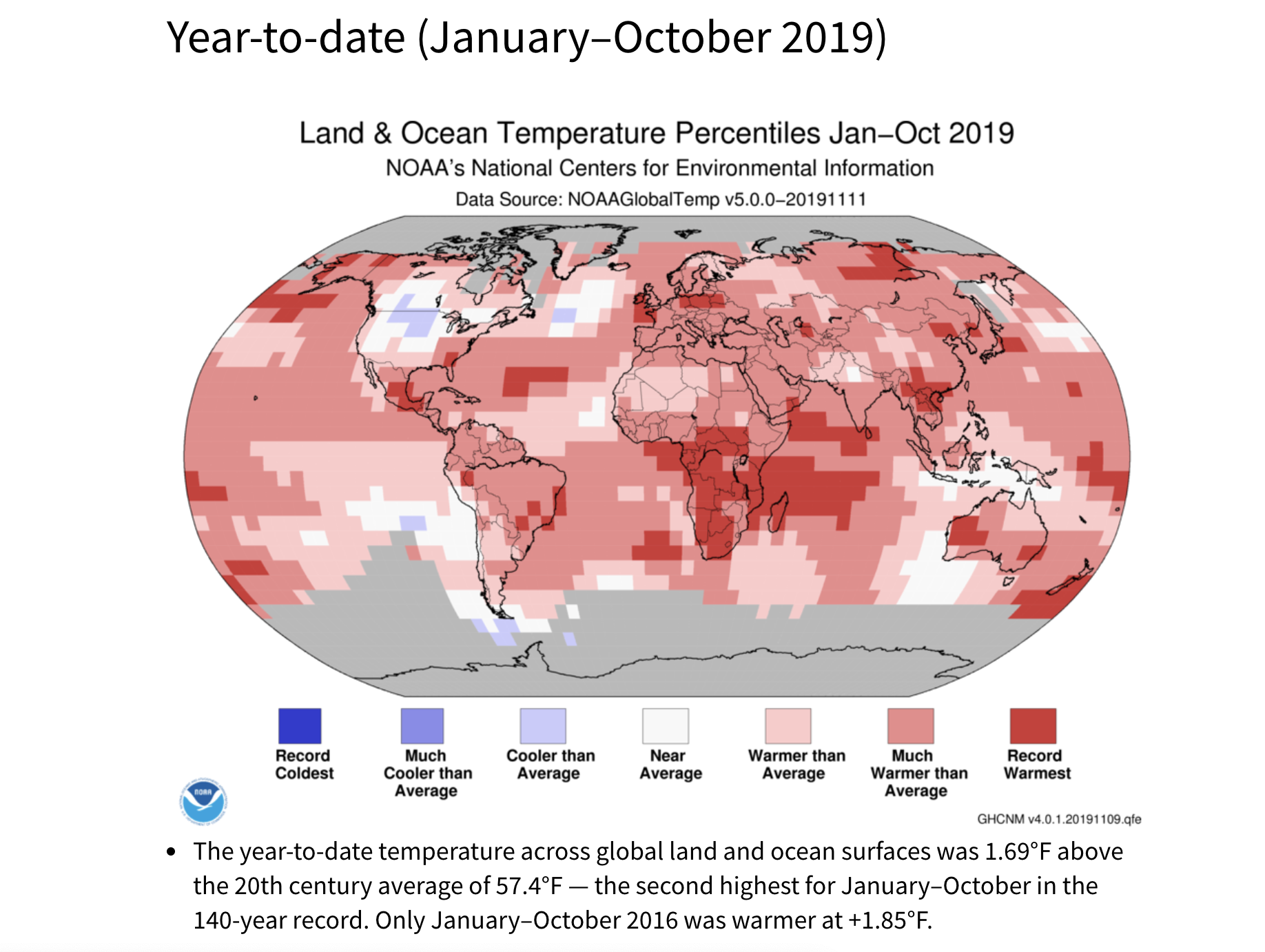
Meanwhile, new projections are revising the risk that cities face from rising sea levels that are caused by melting glaciers due to warmer temperatures.
Maps created by the research organizationClimate Central, and published in the journal Nature Communications indicate that rising seas could flood land thatcurrently home to some 150 million people at high-tide by 2050, if steps aren&t taken to improve the resiliency of cities to flooding or reverse course on climate.
Even the Federal Reserve is waking up to climate change risks. The regulator responsible for U.S. monetary policy convened an event earlier this month to focus on the financial impacts of climate change.
&By participating more actively in climate-related research and practice, the Federal Reserve can be more effective in supporting a strong economy and a stable financial system,& Lael Brainard, a member of the Fedboard in Washington, said in prepared remarks at the same event, according to a report inThe New York Times.
- Details
- Category: Technology
Spending for consumer digital healthcare companies is set to explode in the next few years; the Office of the National Coordinator for Health Information Technology is currently reviewing the requirements for data sharing with the Department of Health and Human Services, and their initiatives will unlock a wave of data access never before seen in the U.S. healthcare system.
Already, startups and large technology companies are jockeying for position over how to leverage this access and take advantage of new sensor technologies that provide unprecedented windows into patient health.
Venture capital investors are expected to invest roughly $50 billion in approximately 4,500 startups in the healthcare industry, according to data from CB Insights. In all, there have been 3,409 investments made in the healthcare market through the third quarter of 2019, with 31% of those deals done in what CB Insights identifies as digital health companies.
The explosion of data is unprecedented and already companies like Apple and Google are jockeying for control over how that data will be served up to healthcare practitioners and patients.
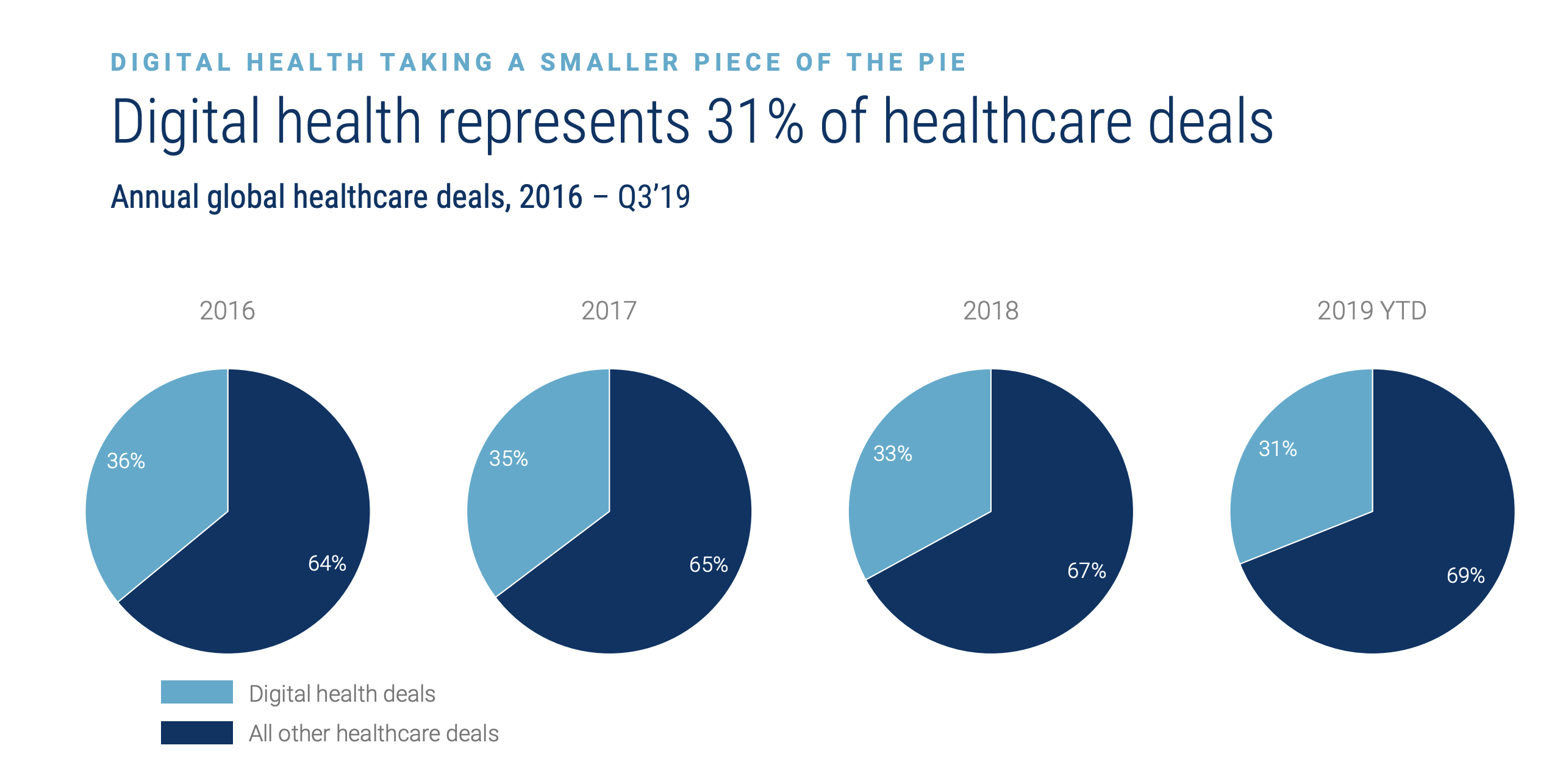
Chart courtesy of CB Insights
Apple and Google are setting out two divergent paths for handling patient data. For patient advocates, therea clear winner, and as startups look to play in these emerging ecosystems, itwhat the patient wants that may matter most.
&The second that this data hits those shiny Silicon Valley apps, instead of being under HIPAA thatcovered, you become a user and you have no rights,& says one patient advocate.
Last week, after reports in The Wall Street Journal and The New York Times, Google confirmed the details of a partnership with religiously-affiliated hospital and assisted living network, Ascension, a deal that involved the movement of millions of patient records into Googleinfrastructure.
The Alphabet subsidiary had first announced the agreement in its July earnings call, but the precise details of its work with the hospital records of Ascension patients were undisclosed until a more detailed description of the project was leaked by a whistleblower.
Google was not only moving patient records onto its cloud infrastructure, but was also developing tools to &help Ascensiondoctors and nurses more quickly and easily access relevant patient information, in a consolidated view,& the company confirmed in a blog post.
For the source of the Journalreporting, there were too many pieces of information about the project that both the Google engineers who were working on &Nightingale& and the doctors and patients in the Ascension healthcare system were kept in the dark about.
As the whistleblower wrote in a Guardian editorial late last week:
With a deal as sensitive as the transfer of the personal data of more than 50 million Americans to Google the oversight should be extensive. Every aspect needed to be pored over to ensure that it complied with federal rules controlling the confidential handling of protected health information under the 1996 HIPAA legislation.
Working with a team of 150 Google employees and 100 or so Ascension staff was eye-opening. But I kept being struck by how little context and information we were operating within.
What AI algorithms were at work in real time as the data was being transferred across from hospital groups to the search giant? What was Google planning to do with the data they were being given access to? No-one seemed to know.
Above all: why was the information being handed over in a form that had not been &de-identified& & the term the industry uses for removing all personal details so that a patientmedical record could not be directly linked back to them? And why had no patients and doctors been told what was happening?
I was worried too about the security aspect of placing vast amounts of medical data in the digital cloud. Think about the recent hacks on banks or the 2013 data breach suffered by theretail giant Target& now imagine a similar event was inflicted on the healthcare data of millions.
Google insists that no patient data is being used to sell ads, or being coupled with either its own consumer data or data from other customers it may be working with in healthcare (a list that includes the Cleveland Clinic, Hunterdon Healthcare, and McKesson).
However, Googlehandling of patient data — through its own work with other partners and through DeepMind Health (a division of a Google spinout which the search giant recently acquired) — has been controversial.
In 2018, the search giantwork with the U.K.National Health Service was criticized for not adhering to data governance standards and potentially breaking the law. And, earlier this year, Google was sued for allegedly mishandling patient data by including too much potentially identifiable patient information used in a study conducted by the University of Chicago Medical Center, Google, and the University of Chicago.
In each instance, Google insisted that it followed all appropriate regulations, but the problem that the company faces is growing concern from a new crop of lawmakers and concerned consumers that the regulations which exist on the books are no longer appropriate.
Technology is coming for healthcare data
The news of Googlework with Ascension and the concerns it has raised among consumers is just one example of the companybroader efforts to capture more of the multi-trillion dollar healthcare market.
Google kicked off November with a $2.1 billion bid for Fitbit — a deal that would potentially put an incredible amount of currently unregulated consumer health data squarely under the magnifying glass of Googlemammoth data analysis tools.
- Details
- Category: Technology
Read more: The coming fight over who controls digital health data
Write comment (92 Comments)Mubi, a 12-year-old on-demand movie streaming and rental service, has arrived in India. Like other streaming services giants such as Netflix, Amazon Prime Video, Apple TV+ and DisneyHotstar, Mubi is offering its service at a slightly lower price in the key overseas entertainment market.
The London-headquartered firm is offering a three-month subscription in India at Rs 199 ($2.8), after which it would charge $7 a month or $67 a year (this way, the monthly cost works out to about $5.5). This is substantially lower than the £9.99 monthly subscription fee it charges to subscribers in the U.K., and the $10.99 it charges in the U.S.
Perhaps the lesser-known streaming service among all the usual names, Mubi has earned a name for itself by offering a selection of critically acclaimed movies. Unlike other services, Mubicatalog is incredibly thin. At any moment, the service offers only 30 recent and vintage movies. One newtitle arrives every day and another vanishes at the same time. No movie stays longer than 30 days on the platform.
Mubi, founded in 2007, started with the ambition of becoming just like what Netflix is today. But it became apparent to the company that they couldn&t afford to offer thousands of titles to users, founder and chief executive of the company Efe Cakarel told The New York Times in an interview two years ago.
&In the beginning, we wanted to be like Netflix, but the unit economies of an ‘all-you-can-eat& site is very capital-intensive,& Cakarel told the Times. &The question becomes, how do you create a compelling experience? If you can&t get 10,000 titles, how about a limited selection?&
Mubi has amassed 9 million subscribers, the company said. (Cakarel will be speaking at Disrupt Berlin next month.)
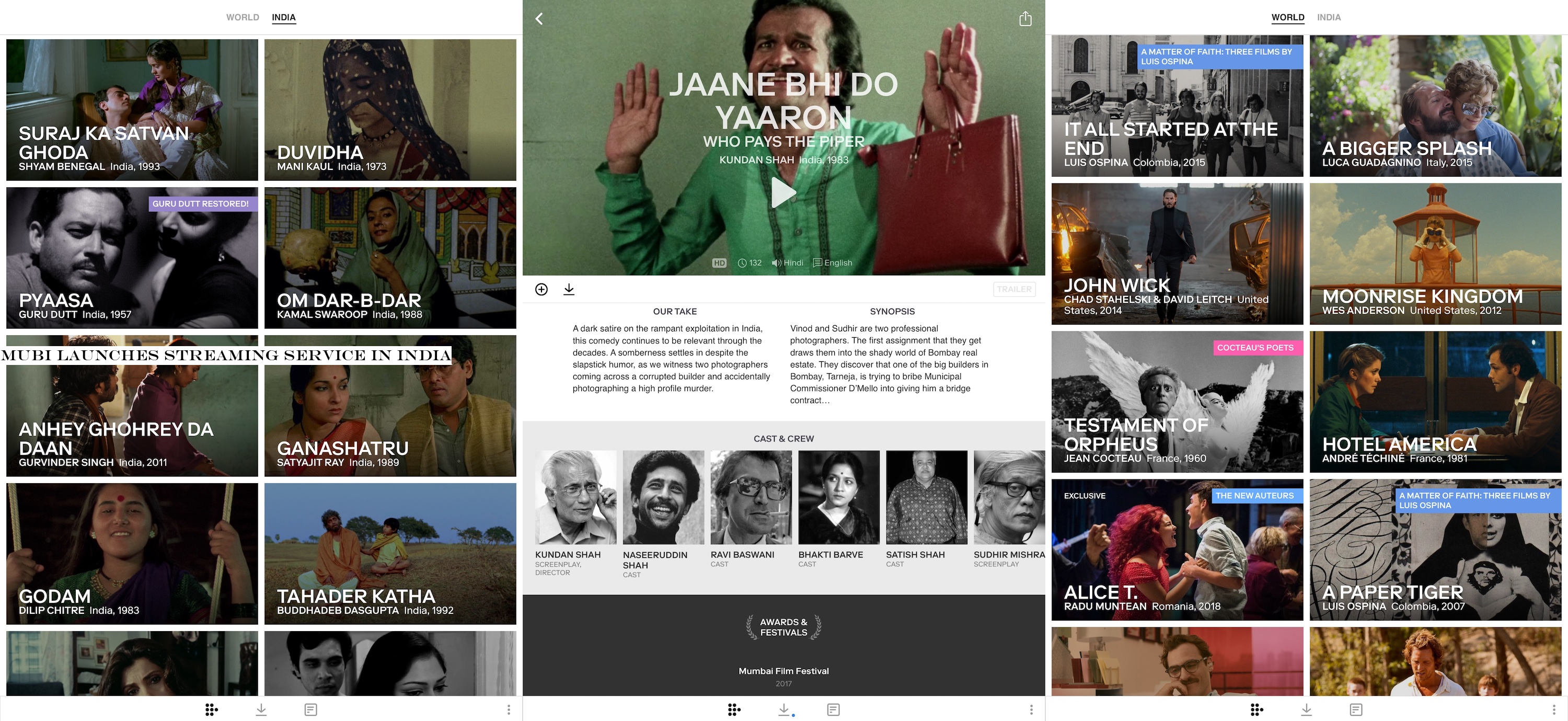
In an interview last month, Cakarel said most streaming platforms are today focused on the biggest TV series. &But Mubi focuses on finding gems, often going back decades, that very few people know of. We are giving distribution to such films. You may not like a film, but it is there for a reason,& he said.
In India, Mubi has additionallylaunched a dedicated channel(first time it has done so for any market), where local movies are being showcased. (Customers in India have access to the global feed as well.) Additionally, like in other markets, Mubi is offering a rental service to subscribers in India, allowing them to pick any movie from a selection of a few dozen for $3.5.
For its India business, the company has appointed film producer and Academy Award winner Guneet Monga (known for titles such as Gangs of Wasseypur, The Lunchbox and Masaan)as its content advisor. It also maintains a partnership with Times Bridge, the venture arm of Indian internet services and content conglomerate Times Internet.
&Monga has the sensibility for great cinema. The kind of films she produces, the kind of films she champions are the type of films more people should see. I cannot be more fortunate that she sees our vision in India,& Cakarel said in an interview.
In a statement, Monga said, &I&m thrilled we have launched a dedicated channel for Indian cinema as it means that film lovers can now watch amazing films like Salaam Bombay and Andaz Apna Apna, alongside globally renowned gems like Moonlight.&
The company has secured deals with local distributors FilmKaravan, NFDC, PVR Pictures, Shemaroo, and Ultra to populate titles on India section every day. Some of the upcoming titles include Kamal Swaroopcult film Om Dar-B-Dar, Kanu BehlBinnu Ka Sapna, which premiered at Clermont-Ferrand International Short Film Festival this year, and ghost film Duvidha from Indian art-house master Mani Kaul.
Mubi Go, a service available in the U.K. and Ireland, which allows subscribers in those markets to get a movie ticket each week in a local theatre, is not available to customers in India.
- Details
- Category: Technology
Read more: Mubi launches streaming service in India
Write comment (94 Comments)Capturing human performances in high-definition 3D is a complicated proposition, and among the many challenges is getting the lighting right. This impressive new project from Google researchers puts the subject in the center of what can only be described as an prismatic LED egg, but the resulting 3D models are remarkable — and more importantly, relightable.
Whatcalled volumetric capture uses multiple cameras in a 360-degree setup to capture what can look like a photorealistic representation of a subject, including all the little details like clothing deformation, hair movement, and so on. It has two serious weaknesses: First, itmore like a 3D movie than a model, since you can&t pose the person or change their attributes or clothing; The second is an extension of the first, in that you can&t change the way the person is lit — whatever lighting they had when you captured them, thatwhat you get.
&The Relightables& is an attempt by a team at Google AI to address this second issue, since the first is pretty much baked in. Their system not only produces a highly detailed 3D model of a person in motion, but allows that model to be lit realistically by virtual light sources, making it possible to place it in games, movies, and other situations where lighting can change.
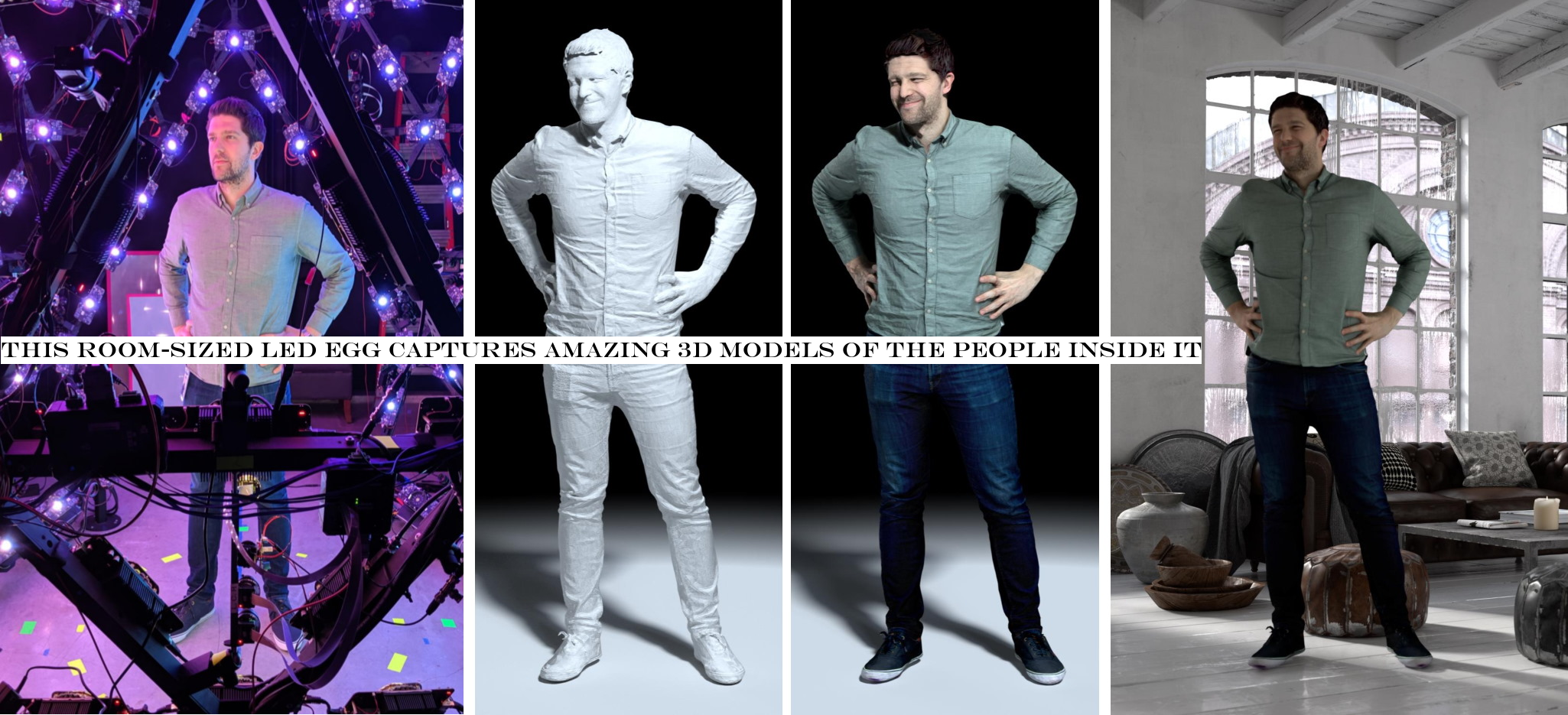
Images from the Google AI paper that show the capture process and resulting 3D model alone and in a lighted virtual environment.
Itall thanks to the aforementioned prismatic egg (and a couple lines of code, of course). The egg is lined with 331 LED lights that can produce any color, and as the person is being captured, those LEDs shift in a special structured pattern that produces a lighting-agnostic model.
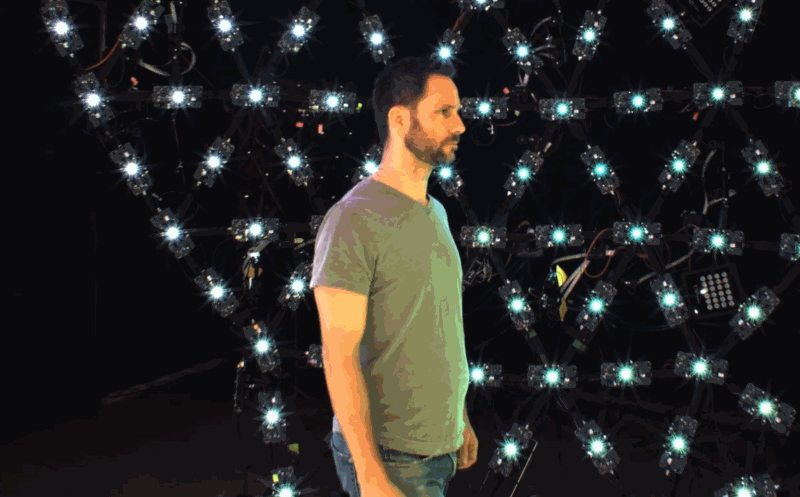
The resulting models can be placed in any virtual environment and will reflect not the lighting they were captured in but the lighting of that little world. The examples in the video below aren&t exactly Hollywood-level quality, but you can see the general idea of what they&re going for.
The limitations of volumetric capture make it unsuitable for many uses in film, but being relightable brings these performances a lot closer to ordinary 3D models than they were before. Of course, you still have to do all your acting inside a giant egg.
&The Relightables& will be presented by the team at SIGGRAPH Asia.
- Details
- Category: Technology
Read more: This room-sized LED egg captures amazing 3D models of the people inside it
Write comment (92 Comments)Page 322 of 5614

 17
17